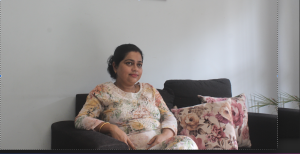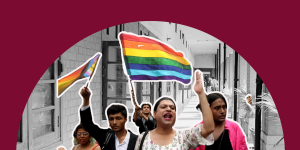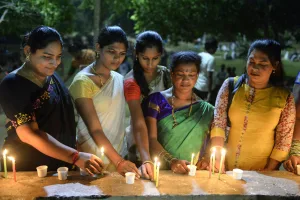Seen-Unseen
In cities like Lucknow and Varanasi, multiple barriers prevent queer women from accessing safe mental healthcare. Some of them turn to their community for comfort.
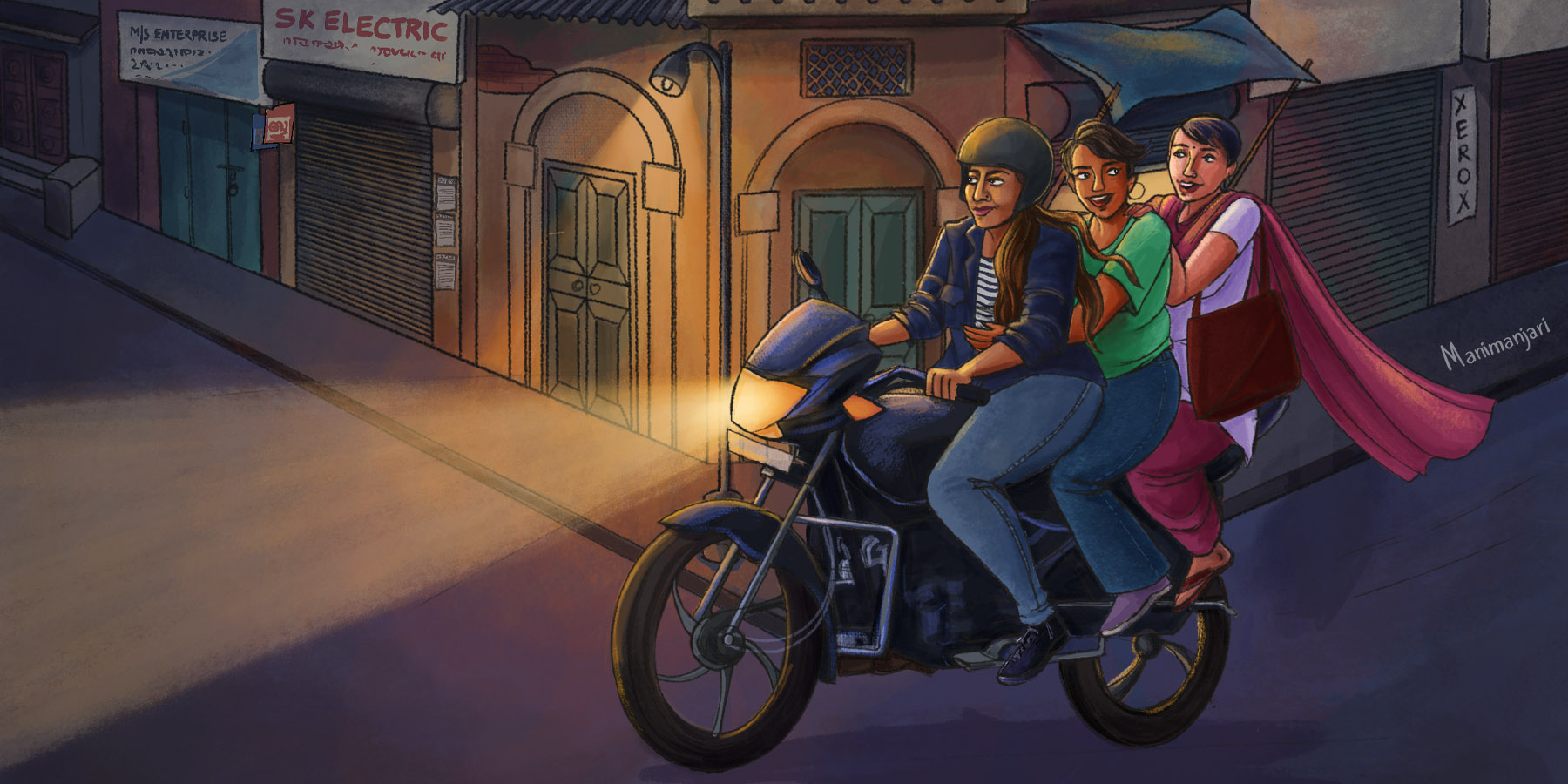
This story was supported by the Pulitzer Center.
In 2014, Komal Dubey found herself stuck in a bleak stretch of depression. She was 18 years old then, and deeply heartbroken. Her girlfriend of five years had been married off to a man. Reacting self-destructively, she disclosed her relationship with her former girlfriend to her family. But, in a circumstance that queer women are only too familiar with, no one took Komal’s relationship or grief seriously.
After a while, an older cousin studying psychology at the King George Medical University in Lucknow offered help. She took Komal, whose real name is not revealed in this story because she is not out in public, from her hometown near Agra to the medical university for counselling. Komal remembers psychiatrist Isha Sharma as a godsend. “She was the only person I’d met who told me, ‘Kisne bola yeh unnatural hai (Who said queerness is unnatural)?’” Komal said when I met her one evening last October. Counselling helped Komal to slowly accept herself, to accept the end of her first love and to move on.
Komal was lucky in that she had the rare positive experience with a mental health professional with regard to her queer identity. Isha assured Komal that she was as normal a person as anyone else and not alone in her predicament. This is in stark contrast to the rejection that many lesbians face, even by medical professionals, when they come out to society. They are often told that their lesbianism is an illness.
The average queer woman in India deals with disbelief, lack of acceptance, social isolation and prejudice that can escalate to coercion and violence by society. This puts them at higher risk of trauma and, therefore, in greater need of mental healthcare, said mental health professionals I interviewed. But it seems that queer women are less likely to receive such help. For one, India’s government mental health infrastructure is vastly inadequate, especially for marginalised communities including queer persons.
The recent government budget for mental healthcare is just 1.3% of the health budget of Rs 89,155 crore, which is roughly 2% of the total budget for 2023-24. Like in previous years, the majority of funds have been allocated to two public and tertiary mental health institutions— the National Institute of Mental Health and Neurosciences in Bengaluru, and the Lokopriya Gopinath Bordoloi Regional Institute of Mental Health in Tezpur. But there is a troubling lack of clarity regarding investment in mental health services at the community and primary healthcare level catering to small towns, notes the Centre for Mental Health Law and Policy (CMHLP), a non-profit in Pune that focuses on strengthening mental health in communities. Secondly, the same gender and sexual prejudices that drive queer women to seek help are prevalent among mental healthcare providers as well. CMHLP adds that the impact of factors like food security, access to livelihood and quality education on mental health cannot be underestimated.
*****
Komal is now in her mid-twenties and lives in Lucknow. This capital of Uttar Pradesh, the largest state in India with an outsize influence in electoral politics, is a bustling city where modern life is located amid colonial and Nawab-era architecture. Lucknow has a beautiful ruin at every turn. For young people congregating here from neighbouring small towns and rural areas, it is the big city. They move here for freedom and opportunity. But for queer youth, and in particular for lesbians and queer women, life here can be a compromise.
Komal’s life in Lucknow revolves around her career. She is a senior pharmacist at a major multispeciality hospital in the city. When she is not at work, she is busy completing coursework for an MBA through distance-learning at her paying guest accommodation in Lucknow. Komal describes herself as “business-minded” and aims to build a pharmaceutical empire.
Her girlfriend lives about 200 km away and visits once a month. On weekends, Komal calls her friends back home. Occasionally, she goes out with the few friends she has in Lucknow.
Given her hectic schedule, Komal found time only at 10 pm one night after work to meet me. I found her soft-spoken and reticent. However, her composure broke when we arrived at the topic that haunts most Indian women her age—marriage. “I’ve told my family I am not interested, but they’re not ready to listen,” she said vehemently. “My mother says, if you’ve been born a girl, behave according to nature.”
Komal laughed uncomfortably remembering how a relative talking about Komal’s resistance to marriage had made an oblique reference to her bout of depression in 2014, when she overdosed on sleeping pills at her girlfriend’s wedding and collapsed. It was also an indirect reference to her sexual orientation.
“Some people are too afraid to ever come out to their families. In my case, they [family] know everything. Still they can’t understand,” Komal told me. When we spoke again several months later, as the arguments over marriage with her family continued, Komal was considering a marriage of convenience or “MOC” as she calls it—a union in which a queer man and a queer woman mutually agree to marry to side-step familial and social pressure. Such a marriage is often a negotiation for autonomy because it allows the partners to separately explore their queer relationships. “I know what is right and wrong, I keep discussing it with my friends and my girlfriend but it gets frustrating,” Komal said. “Now I feel, go with the flow. Jo bhi hoga dekha jayega (Whatever will be, will be).”
Despite relentless pressure from family to marry a man and the knowledge that therapy helped her in the past, Komal was indifferent about seeking professional mental help. Isha, the queer counsellor, was no longer in Lucknow and Komal did not know where to begin to look for another therapist.
Like Komal, I am a queer woman. I live in Delhi where Pride has been a massive production for the past 15 years. I have kissed girls in old ruins and public parks and most of my friends between the ages of 20 and 40 are gay. Yet, on the occasions when I have been with a girlfriend in public spaces, I have confronted the same incomprehension about my identity as Komal. In malls, pubs and expensive South Delhi clubs, men have incessantly hit on us, followed us, refused to believe we are together and offered to fuck us straight.
Even in India’s capital city, the collective Indian imagination cannot conceive of lesbians. When it does, it sees lesbianism as an aberration to be fixed. This attitude has real consequences for queer women’s access to essentials like housing and healthcare. The feeling that such prejudice was worse for lesbians living in India’s many small towns and non-metro cities made me seek out young women like Komal. How, in a state replete with reports of misogyny and violence against women, did they access mental healthcare and find emotional stability?
No Room for Queer Trauma
Lucknow has five large public hospitals with mental health departments. I chose to visit two —King George Medical University and Balrampur Hospital.
The psychiatry department at Balrampur Hospital receives out-patients on weekdays. When I walked in around noon, the line of patients waiting for consultation snaked through the waiting area. One of the psychiatrists there, whom I will call Hardeep because they spoke with me on the condition of anonymity, sat down to talk to me. I wanted some insight into the hospital’s approach to queer patients. How many LGBTQ patients did they see on average, I asked. Hardeep answered with a question, “when I was graduating in 2016, in my viva I was asked whether LGBT is a bimari (disease) or not. What do you think?” “Not according to the DSMV,” I answered. (The DSMV refers to the fifth edition of the Diagnostic and Statistical Manual of Mental Disorders, which is the standard tool for classification of mental illness worldwide.)
“These are very sensitive, complicated topics,” Hardeep continued. “Our first work is mareez ko theek karna (treating the patient). It is very subjective, every patient is different. As a doctor we would reassure the patient, psychoeducate the parents and counsel the patient too. There is no medicine involved since many people have tried but there is no cure.” Hardeep added that “It’s rare that we get LGBT patients.”
In our conversation, Hardeep conflated gender dysphoria, transness, cross-dressing and homosexuality—an inaccurate understanding, which I found to be a common occurrence in my conversations with psychiatrists in Uttar Pradesh.
Hardeep often mixed references to sexual identity and expressions of gender. “The last [queer] girl I saw was brought by her sister who was crying. The girl herself was laughing—wearing boys-clothes and dressed like hip-hop people, with chains and rings,” Hardeep recalled. It seemed to me that Hardeep lacked the empathy, awareness, training, interest, and time to learn the basics or nuances of queer beings and how their mental healthcare needs could be influenced by their identity or interactions with heteronormative society.
As we chatted, Hardeep offered his insights on the subject. “India is not yet a developed country. We’re not sitting in Europe. As doctors, our words carry a lot of weight. If we fully psycho-educate them [queer patients], totally normalise it, this could lead to a queer person rebelling against their family,” he said. Hardeep defended his approach by saying that most people who access the hospital are from lower socio-economic families and are not “very educated”. Doctors have to consider a queer person’s ability to survive without family support and take into account the possibility that the family could abuse the doctors, turn violent or file a police case against the hospital for suggesting that they let queerness be, Hardeep told me. I struggled to maintain equanimity.
The attitude of medical professionals like Hardeep sounds familiar to Ketki Ranade, assistant professor at the Centre for Health and Mental Health at the Tata Institute of Social Sciences in Mumbai. “The attitude is ‘I don’t know, I don’t care’. It’s a mix of apathy, ignorance, and then there is prejudice deeply seated in personal belief which leads to this kind of defensive medicine by psychiatrists,” Ranade told me.
I asked Hardeep about the usual outcome of the queer cases he saw in his practice. “Poor,” he replied, arguing that it was impossible to devote the kind of time queer patients might require from a department visited by nearly 150 people every day. “In fact, we’d say please don’t send us such patients,” Hardeep stressed.
They would rather refer queer patients to bigger hospitals like King George Medical University in the city. Built in 1905, the university serves patients not just from Uttar Pradesh but also from adjoining states including Bihar, Chhattisgarh, Madhya Pradesh and even Nepal.
****
One October afternoon last year when I visited the King George Medical University, the out-patient department was so full that the only psychiatrist on duty, Adarsh Tripathi, had two families in his consultation room at the same time. An old man who held his wife, a silent woman with a ghunghat over her head, described symptoms including paranoia, withdrawal and disinterest in personal grooming. After spending just about a minute on them, Adarsh scribbled a prescription and sent them off. He had no time to speak with me.
Later, I called another psychiatrist at the university who also happened to be a gay man. I will call him Sachin because he is not out to all his colleagues. Sachin told me that the psychiatric department was overburdened with a footfall close to 90,000 new patients annually. He has been noticing a disturbing pattern, he said, among some older mental health practitioners of diagnosing queer persons who had disclosed their identity with obsessive compulsive disorder or OCD. “There is a need for a detailed work-up instead of which often you see doctors will put them on fluoxetine [commonly known as Prozac] and over time this over-medication would lead to extra-pyramidal effects [uncontrolled movements such as tremors, smacking lips, and leg jiggling] and cognitive dullness,” he pointed out. This mode of treatment could also be a face-saving attempt by doctors to show that they have treated the patient, Sachin added.
I discussed this bizarre practice with Ranade who said they had come across such practices. They explained that after the Indian Supreme Court decriminalised same sex sexual activity and homosexuality as a disorder was removed from the DSMV, psychiatrists avoid saying that they can “treat” homosexuality because that could cost them their medical licenses. That creates the space for backdoor diagnoses with a twisted logic, said Ranade, that if a patient’s sexuality is making them unhappy, the psychiatrists use a diagnostic label like OCD, depression or adjustment disorder, so they can go ahead and treat it.
Queer clinicians like Sachin who find themselves as much on the fringes of the mental healthcare system as queer patients, believe that these institutions need to be made safe for LGBTQIA+ persons. “There needs to be a proactive push for acceptance,” he said. “Government hospitals, medical colleges and clinics should have specific mention of being LGBTQ+ friendly, in the same way that they are supposed to be disabled-friendly or have a women’s cell. The same way that without a ramp a hospital will not pass government inspection, there should be a mandatory safe space or forum for queer communities in higher institutions.”
Despite the presence of such large government mental healthcare facilities in Lucknow, a private psychiatric centre, Nur Manzil, appeared to be the most popular. But it is visited by fewer people because it is much smaller and has a higher consultation fee. Hemant Naidu, the centre’s director, estimated that of the roughly 3,000 new patients Nur Manzil receives every year, only four or five disclose that they are queer (mostly gay). Naidu said that in the last 20 years he had seen only three or four lesbians and no transgender people. Families sometimes brought in girls who had run away together, or escaped marriages, asking for them to be “cured” with medication or counselling. These families stopped coming to Nur Manzil when they realised that neither medication nor counselling could make queerness disappear, he said.
Conditional Freedoms
Komal’s friend Nishi took me to meet the “community”—how queer folks I met referred to their group—at the house of Darvesh Singh, a 46-year-old gay activist. Singh organised the first Pride event in Lucknow in 2017 with a few others. He said that there was still great need for awareness and acceptance of the queer community in Lucknow’s small town environment.
The gathering at Singh’s house comprised a number of gay men and one other woman, Priyam. I was told that this was an accurate representation of most queer events in Lucknow—abysmally low visibility of women. Within the community, lesbians were not taken seriously, many in the group admitted. Friendships between gay men and lesbians were rare. Furthermore, women in Lucknow, like in many other Indian cities, knew that their freedoms were already restricted and conditional on factors like what they wear, their company and time of day. And being queer they were hypervigilant about protecting their identity because if they are “outed” by someone, they could lose even the little freedoms they have. “These things have happened to close friends,” said Priyam whose friends call her the app-queen and brand ambassador of Lucknow’s lesbians.
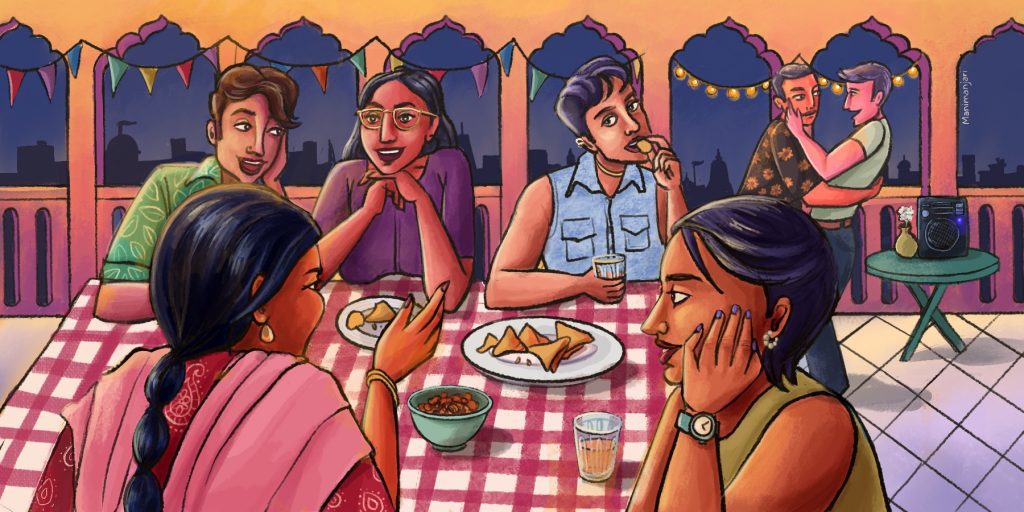
At Malkin’s Chai and Chuski
I travelled to Varanasi to meet Neeti, a 33-year-old openly lesbian program coordinator at Asian Bridge India, a non-profit focused on improving living conditions of poor and marginalised communities. She is also the president of Prismatic Foundation, a recently founded queer-community organisation in the city. The first thing on her agenda was a welcome party for me at the café Malkin’s Chai and Chuski, which she and her friends had made their adda (hangout). They are a tightly-knit mix of masc lesbians, non-binary persons, trans women, cis gay men and queer persons.
There was Shanu bhai, a 32-year-old masc lesbian travel agent from an orthodox Gujarati family. They were given to joking around but also ensured everyone felt included. Their best friend Sushma is a bespectacled bisexual, dressed in formal attire and the heir to a chain of prominent medical centres in Varanasi. Shanu and Sushma met on OK Cupid, a dating app, but decided that they had bhai-wala (fraternal) feelings for each other. Shivani, also known as RJ Suraj when he moonlights as a radio jockey, is in his early thirties, and works as a solderer. Shivani identifies as male but presents as female for his beloved single mother. That evening, Shanu was having a hard time with the fact that Shivani had just pierced his ears.
Malkin’s owner, Ana, a 37 year old soft-spoken trans woman, sent out a constant stream of appetisers. Randhir and his boyfriend Rahul, who are students at Banaras Hindu University, slow-danced through the evening and were prone to elaborate displays of affection. The group experienced a freedom in this company, which was a stark contrast to life outside where, according to Shivani, “Na chahte hue bhi ek boundary mein rehna padta hai (We unwillingly have to maintain certain limits on our behaviour).”’
Till two years ago Neeti’s life was far from this easy camaraderie at Malkin’s. “The Neeti in front of you, I was the complete opposite,” she told me. She is now confident, outspoken, self-assured, and comes across as the mom-friend of the group. Earlier she was meek—a consequence of a 12-year relationship characterised by serial infidelity, possessiveness, lack of privacy, and relentless emotional and physical violence. At one particularly low point, Neeti had a broken finger and 14 muscle injuries. Her colleagues at the non-profit organisation Sahayog insisted she leave her girlfriend, when she showed up to work after a fight, unable to walk. “By then I’d stopped taking on domestic violence case-work because I felt like a hypocrite,” she recalled.
At that time, Neeti found her ex-girlfriend’s behaviour passionate and romantic calling it “aashiq wala type”, but now she described her ex-girlfriend as dictatorial, patriarchal, controlling and extremely masculine. Such behaviour could itself be a manifestation of a response to stigma. “How does a lesbian assert their masculinity?” Ritwik, a trans femme activist in Lucknow, ventured. “If you wear shirt-pant, you’ll still be clocked as a woman. So, instead, you up the masculine behaviour you’ve seen around you. You order people around, get aggressive, jealous.” Vibha Rungta, a queer psychologist formerly based in Lucknow said that the lack of awareness, openness and healthy models of behaviour, can lead to toxicity, violence, and substance abuse in some queer relationships.
Neeti comes from a lowered caste, described as OBC or “Other Backward Classes” in official records, whereas her ex-partner is Brahmin, a historically privileged caste. Her ex-partner’s mother would keep separate utensils for people from lowered castes and didn’t allow them to sit on her bed, but treated Neeti as an exception. The casteist practices led to frequent arguments between Neeti and her ex-partner. Neeti observed that people from dominant castes learn supremacy in their bodies in the same way that a man learns masculinity in a male body. She sounded conflicted about whether her ex-girlfriend’s violent behavior was connected to her caste.
Neeti’s relationship shaped her life to such a degree that she was still getting her bearings two years after it ended. “Sometimes I feel that I’ve fallen so behind, I’ll never get those years of my life back,” she told me. Still, as part of the non-profit space, Neeti had access to an affirming environment. Her colleagues and friends urged her to see a counsellor. During the pandemic, she had some telephonic therapy sessions with a psychologist in Kolkata. It helped her cope with chronic insomnia. Today, Neeti is a powerhouse juggling two projects at work, and coordinating LGBTQIA+ community activities in the city. “And since I met this group, I am ekdum relaxed. Humko duniya mil gayi (It’s like I have been gifted a whole new world),” she said, her face lighting up.
Neeti’s network of friends filled not only a social need but also provided a mental health safety net in a city that lacked safe access to professional mental healthcare for queer people. I visited the privately-run Deva Institute of Healthcare, which was one of the first results on Google when I looked for mental health facilities in Varanasi. The out-patient department was smaller, more private and less crowded than hospitals I visited in Lucknow. Venu Gopal Jhawar, the senior psychiatrist, told me that the hospital gets roughly eight queer clients in six months, and estimated that lesbians made up only about 20% of the institute’s queer patients. Like Lucknow, many patients were below 18 and their families had brought them to be “treated” out of queerness. Queer people who visit the facility themselves seek help from relationship-related stress and depression arising from discrimination, said Jhawar.
Next I visited Pandeypur mental hospital, a government institution, in north Varanasi. The psychiatric out-patient department was so crowded that it took me an hour just to get the phone number of Amarendra Kumar, the director and chief superintendent of the hospital. Over a call he told me that there are only three government mental hospitals in all of Uttar Pradesh—in Agra, Bareilly and Varanasi—serving a population of 200 million people in the state. “I’ve been practicing for at least 15 years. Initially there would be 25-50 new patients at the OPD, now we get 450 to 500. The facilities should increase with the number of patients but this hasn’t happened,” Kumar said.
The Pandeypur hospital did not have a fully-fledged psychiatric unit with psychiatric social workers and support staff that it needed. Kumar said that in his entire career he had seen only one openly queer patient—a gay man. “It’s very rare to see such a patient,” he told me. “The patient cannot openly express this [ homosexuality] because of social stigma and the perception that this is unnatural. Especially in this belt of Uttar Pradesh, Bihar, Madhya Pradesh where the thinking is more conservative and conventional. Here people think this is sickness.”
Neeti’s friends are all in varying stages of “being out” to their families. Many have told their mothers. But, mostly, they do not feel that they can be openly queer. None of them, apart from Neeti, has seen a psychologist even if they needed to. They fear that this official relationship between doctor and patient, no matter how private, could result in being outed and bring unwanted judgment.
“Ana is our counsellor,” Shanu joked. At Malkin’s, they turned up the volume for a Bhojpuri song playing on radio. “You need the Banaras-wali feeling,” Shanu said, using the local, more intimate name for the city. At that point the night hit a euphoric fever-pitch. Everyone was drunk on whiskey and dancing in a room filled with the haze of hookah smoke. Abhishek, a friend of Neeti’s, who had the silkiest hair I’d ever seen, jumped up to perform a mujra as the speaker sang, “Saiya ji dil maange, gamchha bichai ke. (My lover asks for my heart as he spreads a sheet on the ground.)”
The Right To Your Own Life
In Lucknow, I spent an evening with Priyam (“the app-queen and brand ambassador of Lucknow’s lesbians”) and two of her friends that was in equal parts melancholic and beautiful. I met Anuradha and Avni, whose names have been changed to protect their identities, at a café. Both are lesbians in their thirties, like me. I explained to them that I was trying to understand the pressures of queer life and access to mental healthcare in Lucknow. Avni stared at me mystified. “Humein kya hua hai? Hum toh theek hai (What has happened to us? We are fine),” she said.
Avni had a traumatic childhood, having been separated from her mother and sister when she was six. She had survived suicide-attempts, self-harm, and depression but waved it all away that day. “We’ve got only one life and we have 100% right over that,” she said firmly. “We do have a responsibility towards our parents, but only we have the right to decide how we want to live life”
She works in real estate and keeps her sexual orientation hidden at work. So does Anuradha, who is a teacher at an elite primary school. Anuradha wore no make-up, had a messy braid, and laughing eyes. Funny and charming, she is the only child of elderly parents whom she cannot trust to comprehend her sexuality. Anuradha told me how she was outed by a classmate she confided in. At that time, she only wanted to see what saying the words felt like.
Anuradha talked about the anxieties she faced—family pressure to marry and to wear feminine clothing which was dysphoric to her—that led to anger, irritability, the urge to break things and hurt herself by hitting her hands on a wall. “I used to talk to myself,” she said. “My mother would have left the room after our argument, but I’m still continuing the dialogue in my head for hours, with all the unsaid things, and literally grinding my teeth. I realised that something is very wrong.”
Six months ago she tried counselling in the form of three online sessions. It helped for a few days. “I want to be myself but I’m not able to,” she said. “My life will change only when someone tells my parents [that I am gay] because I do not have the courage to do it.” The weariness and resignation in her voice was painful to witness. I asked Anuradha and Avni whether they would consider therapy if they found a reliable queer-affirmative practitioner. “There was a phase where we desperately needed someone to be there,” Anuradha said. “[I had] daily suicidal thoughts and cried all night. If we’ve gotten used to repressing [our feelings], and passed that phase, we’ll get over whatever new crisis arises too.”
Avni felt that as older queer women they had been through the worst and learnt to deal with trauma themselves. But she thinks that younger people need not learn the hard way. They should access therapy if they need it, she said. “The kids can still be saved,” from acting out in self-harm and isolating themselves in distress, she hoped.
Before dropping me at my hotel that night, Priyam and Avni took me on a drive-by tour of Lucknow’s Chowk region. All three of us were on Avni’s motorbike. Avni wore a black leather jacket and a helmet. With a lit cigarette dangling from her mouth, and mischief in her eyes, she looked effortlessly cool to me. We sped by the iconic Rumi Darwaza, the ghanta-ghar and the two Imambaras. At 11.30 pm the roads were empty except for us three dykes, whipping by the city at high speed and it felt a lot like freedom.
[This story is reported and produced by queerbeat in collaboration with Behanbox.]
[ Illustrations by Manimanjari Sengupta(she/they). Manimanjari is a painter and illustrator with a background in Sociology and Law. Their work is rooted in challenging the status quo laid down by patriarchy and highlighting lived experiences of women and non-binary folk.]
We believe everyone deserves equal access to accurate news. Support from our readers enables us to keep our journalism open and free for everyone, all over the world.
